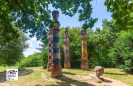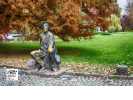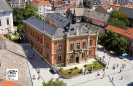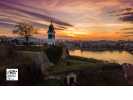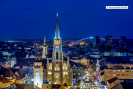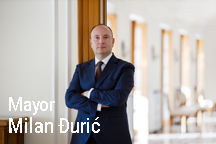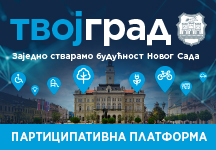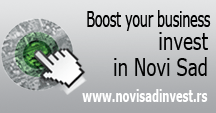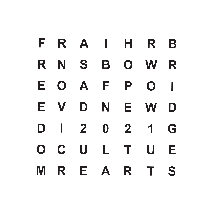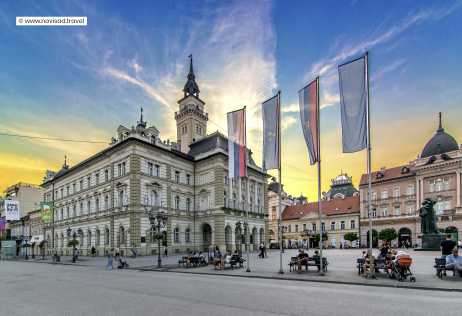
NOVI SAD – THE EXPERIENCE YOU MISS
Novi Sad attracts visitors with its orderliness, safe anchorage by the Petrovaradin fortress - "Gibraltar on the Danube", different languages spoken by its inhabitants, festivals, fairs and a rhythm that deviates from the busy, chaotic city time. Even the clock on the fortress shows hours here with its longer hand and warns that minutes can sometimes wait until a moment of beauty is absorbed, a friendly chat ends, or enjoyment on the Danube sand, the joy of a walk after spring rain or Sunday lunch. The rhythm of authentic relaxation of Novi Sad also pulsates outside the city on isolated farms (salas), Danube inns, beaches or over the expanses of Fruska gora.
Novi Sad, the holder of two prestigious titles – 2019 European Youth Capital and 2022 European Capital of Culture, is a city that, with its urban center and rural surroundings, offers its visitors an agenda of incredible content. Each visitor, according to their inner sense of beautiful and pleasant, attractive and cheerful, useful and accessible, can create their own atmosphere by getting to know all the layers of the past and present of Novi Sad.
TOURIST ZONES AND ATTRACTIONS:
FREEDOM SQUARE is the central city square of Novi Sad. It is surrounded by the most representative city buildings and palaces. The town hall was built in the neo-Renaissance style in 1895. The most impressive elements of the facade are the statues of Greek goddesses. On the opposite side of the square there is the Roman Catholic Church of the Name of Mary, built in the neo-Gothic style according to the design of Djerdj Molnar in 1895. With a 73-meter high tower, it is the highest place of worship in the city. Windows are set with stained glass made in Pest. The central place on Freedom Square is occupied by the Svetozar Miletic Monument, the most famous figure of the city of the 19th century. The bronze statue is the work of the famous Croatian sculptor, Ivan Mestrovic.
ZMAJ JOVINA STREET is the main street in the pedestrian zone of Novi Sad. In the past, there was the market stretching along this street, and today there are shops, restaurants, pastry shops, craft shops inside old preserved houses and hidden passages. The street ends with the building of the Bishop's Palace of the Eparchy of Backa, built in 1901 in the Serbian-Byzantine style. In front of the Palace there is a monument dedicated to Jovan Jovanovic Zmaj, a famous poet after whom the street was named.
PASICEVA STREET used to be a furrier alley, recognizable for its artisan shops with leather products. At the beginning of the street there are the Serbian Orthodox Church of St. George (the Cathedral Church) and the Platoneum Building, the endowment of Bishop Platon Atanackovic, today the seat of the Serbian Academy of Sciences and Arts - Branch in Novi Sad. The house on the corner of Grckoskolska and Pasiceva, known as the "House near the Icon", is the birthplace of Marija Trandafil, the greatest benefactor of the Serbs. Pasiceva Street ends with Marija Trandafil Square, where the seat of Matica Srpska, the oldest and most respected Serbian cultural and scientific institution, is located. The Nikolajevska Church is near, the oldest Orthodox church built in 1730. The sons of Mileva and Albert Einstein were baptized in the church in 1913.
DANUBE STREET AND DANUBE PARK Danube Street is one of the oldest streets in the pedestrian zone, connecting the banks of the Danube and Zmaj Jovina Street. It starts with the oldest house in the city, "The House at the White Lion" and the City Library. Many passages hide shops, souvenir shops, pastry shops and restaurants. Danube Park is a protected natural asset and one of the most beautiful parks in Novi Sad. In addition to different types of trees, the park is also decorated with the busts of poets Mika Antic, Branko Radicevic, Djura Jaksic, etc.
REPUBLIC SQUARE WITH FISH MARKET
Republic Square is decorated with a monument dedicated to King Petar I Karadjordjevic. It extends from the Grammar School "Jovan Jovanovic Zmaj" to the Fish Market. From a place that served to supply citizens with fresh fish in the middle of the 19th century, the Fish Market has grown over time into a typical green market with a rich offer of fresh agricultural products, poultry, fish and groceries. Today, it is also a point of meeting and presenting traditions in the production of food, craft products, wine, and honey.
JEVREJSKA STREET is dedicated to the Jewish community in Novi Sad. The center of spirituality and culture of the Jews of Novi Sad is the Synagogue, one of the four that exist in Serbia today. The Synagogue complex with accompanying school buildings and the Jewish city hall was built from 1906 to 1909 according to the design of Lipot Baumhorn, an architect from Pest. The entire complex was built in the art nouveau style, and the facade is decorated with ornaments. Today, the Synagogue is mainly used as a concert hall.
THE PETROVARADIN FORTRESS is one of the largest, best-preserved and most complex fortresses in Europe. Never conquered, the Petrovaradin fortress - "Gibraltar on the Danube" was built between 1692 and 1780. The fortress has an Upper and a Lower Town ("Podgradje").
The upper town is dominated by the Clock Tower, whose large hand shows hours and the small hand shows minutes. The underground military galleries are a four-story communication and defense system about 16 kilometers long and a unique attraction of the Petrovaradin fortress. They are available to visitors with the professional guidance of the Novi Sad City Museum tourist department.
ART STUDIOS The Petrovaradin fortress is also home to artists. The association of artists "Likovni krug" is one of the largest informal art colonies worldwide, which gathers painters, sculptors, designers, photographers. Visitors to the fortress may (with the permission of the artist) visit studios, buy paintings, and often have an unforgettable experience talking to artists, many of whom created their life stories on almost all continents. The institution for artistic tapestry manufacture "Atelje 61" is a unique cultural institution of special importance for Novi Sad, as one of five similar institutions in Europe.
Visitors to "Atelje 61" may witness the creation process and see part of the rich collection of artistic tapestries.
CREATIVE DISTRICT Also known as "Chinatown" by the locals, it was made on the site of a former factory. Former warehouses, halls and workshops have been replaced by cultural institutions. This area represents one of the central ideas of the 2022 European Capital of Culture. The Liman Cultural Station with the OPENS Youth Center and the Student Cultural Center - Fabrika stand out for their numerous cultural and creative programs.
NOVI SAD ON THE DANUBE In the area from the confluence of the Danube-Tisa-Danube canal to the Danube to Strand beach, a landscaped promenade stretches along the very bank of the Danube. The central point of the quay is occupied by the Monument to the Raid Victims, the work of a famous Novi Sad sculptor, Jovan Soldatovic. Strand is the most popular city beach and one of the most beautiful ones on the Danube, equipped with all the necessary infrastructure for a pleasant and meaningful stay for visitors. In the summer, Strand is one of the liveliest areas in Novi Sad, where sports competitions, concerts and festivals take place.
Ribarsko ostrvo and Kamenjar are also near, weekend villages with numerous inns (carda), restaurants, a tourist settlement, piers and a starting point for setting off for a ride along the Danube.
FRUSKA GORA
The mountain of Fruska gora is the oldest national park in Serbia. The wealth of flora and fauna, the thermal springs of the Vrdnik spa, lakes, arranged picnic spots and hiking trails provide excellent conditions for relaxing in nature and recreation activities such as hiking, cycling, hunting and fishing. It is also known as the "Serbian Holy Mountain" because there are as many as 16 monasteries, which had been meeting places of the spiritual life of Serbs for centuries, but also centers of literacy, literature and art.
WINERIES
The surroundings of Novi Sad, especially the slopes of Fruska gora, represent the area of quality wines, where the wine centers of Sremski Karlovci, Irig, Banostor and Sid stand out. With the tasting of your choice in wine cellars, you will learn a lot about the long tradition of viticulture, the manner of wine production, as well as some small wine secrets, all seasoned in a pleasant atmosphere with the specialties of the local cuisine.
Despite the fact that Novi Sad is an urban area, within its territory there are vineyards and family wineries with a long tradition of wine production. The Novi Sad wine route nowadays extends both on the Backa and Srem sides of the city. On the Backa side, there are wineries in Kovilje and Begec, and on the Srem side in Sremska Kamenica and Ledinci. Part of the tradition is also the modern assortment of grapes for the production of white Fruska gora wines: Italian Riesling, Chardonnay, Zupljanka, Sauvignon, Traminac, then Neoplanta, Sila, Rhenish Riesling, etc., as well as red wines: Merlot, Probus, Frankovka, Portugizer, Cabernet Sauvignon, Cabernet Franc, Pinot Red, etc.
SALAS FARMS Salas farms are houses with economic facilities scattered across the plains of Vojvodina and the slopes of Fruska gora. In the atmosphere typical of Vojvodina rural households in the shade of orchards, with traditional food and quality wines and fruit brandies, you can slow down time and enjoy, at least for a moment, with the music of tamburitza players. Accommodation in authentic rooms of the old "altdeutsche" style and horse riding are also available at certain salas farms.
INNS Experience for all the senses on the banks of the Danube, is especially provided by inns, specific local fish restaurants that live on and from this great river. The flavors of fish soup, catfish, carp, perch and small sturgeon dishes, accompanied by famous Fruska gora wines and the sound of tamburitza players will convince you about this.
MUSEUMS AND GALLERIES:
1. CITY MUSEUM OF NOVI SAD
Address: Petrovaradin fortress 4
Exhibitions: Novi Sad from the 18th to the 20th century; Underground military galleries
Collections and dependencies:
Collection of foreign art (Dunavska 29);
Native collection of Sremski Karlovci
(Patrijarha Rajacica 16, Sremski Karlovci);
Memorial collection Jovan Jovanovic Zmaj
(Jovana Jovanovica Zmaja 1, Sremska Kamenica)
2. MUSEUM OF VOJVODINA
Address: Dunavska Street 35 – 37
Exhibition: preserved traces of material and spiritual culture from the area of Vojvodina from the Paleolithic to the 20th century
3. MUSEUM OF CONTEMPORARY ART OF VOJVODINA
Address: Dunavska Street 37
Exhibition: contemporary artworks
4. NATURAL HISTORY COLLECTION OF THE INSTITUTE FOR NATURE CONSERVATION OF VOJVODINA PROVINCE
Address: Radnicka 20a
Exhibition: natural heritage of Vojvodina
5. GALLERY OF MATICA SRPSKA
Address: Trg galerija 1
Exhibition: Serbian paintings and graphics from the 17th to the 20th century
6. THE PAVLE BELJANSKI MEMORIAL COLLECTION
Address: Trg galerija 2
Exhibition: the collection of Serbian fine art of the first half of the 20th century
7. GALLERY OF FINE ARTS – GIFT COLLECTION OF RAJKO MAMUZIC
Address: Vase Stajica 1
Exhibition: collection of works by contemporary Yugoslav artists
EVENTS:
The rhythm of the city can be felt in any of over 200 events arranged throughout the year, suiting all tastes.
In the middle of March, by saying goodbye to the winter weather, a period arrives that brings the awakening of nature, a burst of new energy and a feeling of joy. This is precisely why recreation activities, such as the Fruska Gora Mountaineering Marathon, take place in these months. The most important fair event - the International Agricultural Fair, is held in the spring.
When the sun bathes the streets of Novi Sad, outdoor events take place. The festival that has brought Novi Sad world fame and recognition - "EXIT", hosts over 1,000 performers on more than 40 stages and festival zones every July. At the Petrovaradin fortress, as part of this multiple award-winning festival, the greatest names of the world music scene perform.
Autumn is reserved for hedonism, enjoying the magical flavors of Vojvodina cuisine and the miraculous colors of nature, but also for tough sporting endeavors at the Novi Sad Marathon.
As the year draws to a close, the festival atmosphere is at its peak, and the spirit of Winter Fantasy can be felt in the fairy-tale decorated streets and squares, the smell of mulled wine and delicious cakes at the Christmas markets, the sound of ice skates gripping the ice and the thunderous sound of fireworks on New Year's Eve.
TOURIST TRAFFIC The Tourism Organization of the City of Novi Sad (TONS) has been dedicated to the development and promotion of tourism in Novi Sad since its establishment in December 2008. A handful of creative ideas, innovative solutions, hard work, commitment and dedication have brought visible results. Thus, based on the official data of the Statistical Office of the Republic of Serbia, the number of arrivals of domestic and foreign tourists in 2009 was 83,981, and in 2022 it increased by over 160 per cent and amounted to 218,973. As for overnight stays by tourists, in the year when TONS was founded, they amounted to only 161,709, and in 2022, domestic and foreign tourists achieved more than half a million overnight stays, 561,062 to be precise. The increase in the number of overnight stays was, therefore, 247 per cent.
TONS accepts tourists in its two info centers, one at Freedom Square and the other at the railway station. During 2022, they were visited by a total of 9,729 tourists from 85 countries, of which 6,021 foreign tourists and 3,708 tourists from Serbia. Among foreigners, the most numerous were tourists from Germany, followed by Russia, France, Turkey, Great Britain, India, Spain, Slovenia, Croatia, and the USA.
According to data from the Port Governance Agency, 372 passenger ships docked at the passenger terminal in Novi Sad in 2022, and 35,301 passengers disembarked. The most vessels docked in June (68), when the largest number of passengers (6,683) disembarked. It is followed by May, with 65 vessel arrivals and 6,321 passengers, and September, with 53 arrivals and 5,556 passengers.
Please find more detailed information about the tourist offer of Novi Sad on the official website of the Tourism Organization of the City of Novi Sad – https://novisad.travel.




